
Sioux Falls succeeds by saying YES to BIG IDEAS
How private-public partnerships turned the impossible into reality.
It’s so easy to say no.
When the last students walk out of an old high school, when the aroma of popcorn no longer wafts from a movie theater, when big-name performers tour elsewhere and when others view Sioux Falls as not big enough, it is much simpler to scowl and shrug, accept a negative situation
and walk away.
But with a no-can-do attitude, today in Sioux Falls there wouldn’t be a Washington Pavilion of Arts and Science, a renovated State Theatre, a Sioux Falls Convention Center, Denny Sanford PREMIER Center, Levitt at the Falls or any of the other projects and efforts that make Sioux Falls special. And without the willingness to enter in these public-private partnerships such as these, Sioux Falls would not be the Sioux Falls it is today.
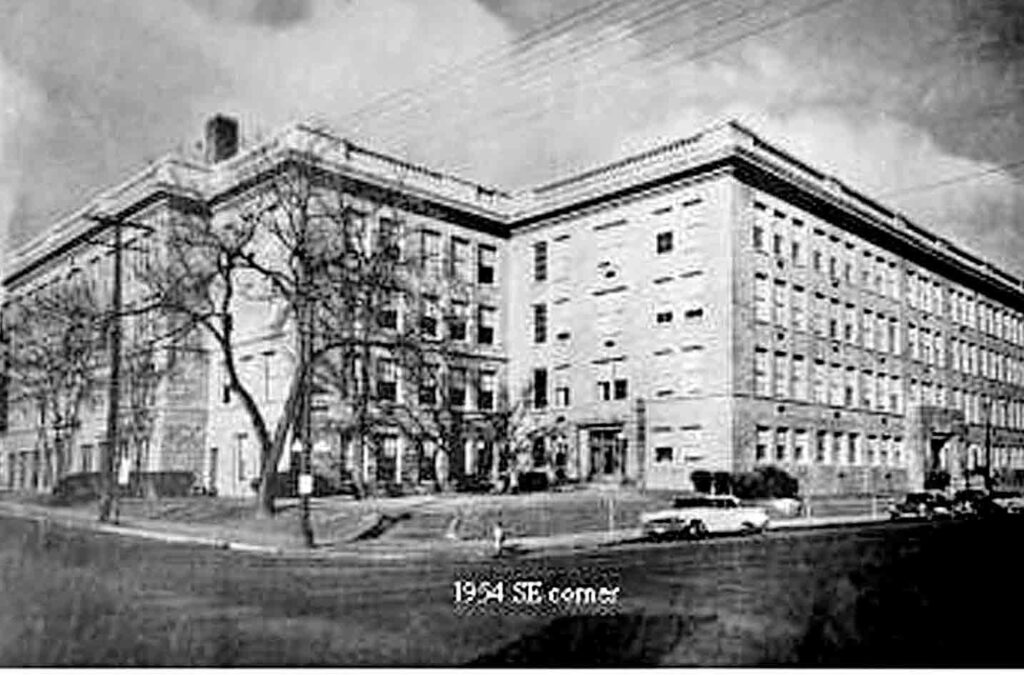
In a community that can point to dozens of public-private partnerships, and with a chamber of commerce that has helped raise more than $60 million in Community Appeals campaigns, Sioux Falls does not take no for an answer whether it is repurposing historic buildings or creating a space to enrich the arts. And every accomplishment took resilience, vision and a refusal to walk away.
Jeff Griffin, president and CEO of the Greater Sioux Falls Chamber of Commerce, knows of no other Chamber of Commerce that has anything like the local Community Appeals.
“I remember learning about it during my job interview and thinking how is this possible? I have been in Sioux Falls for five years now and I have learned not only how it is possible, but also why it is essential,” he said. “Raising the dollars for the projects is the marker of success, but the camaraderie and volunteer development around communitywide shared projects keeps the fire burning for the next campaign.”
It is, in fact, more than possible.
Born and raised in Sioux Falls, Joe Henkin co-founded the advertising agency HenkinSchultz Creative Services before he retired several years ago. As co-chair of the State Theatre’s Community Appeals Campaign, he had a front-row seat for the efforts to reopen the downtown Sioux Falls landmark. It took more than one group to accomplish that task, he said.
“It was the city, it was the (Greater Sioux Falls) Chamber of Commerce, it was private citizens. It all took that effort to get it done,” Henkin said, showing that these collaborations know no boundaries.
Sioux Falls leaders in corporate businesses, in banking and in healthcare aren’t afraid of competition, said Miles Beacom, CEO of PREMIER Bankcard since 1993. Beacom is also this year’s Chamber’s board chair. He stated that new businesses know from Day One that there is an expectation they will give back to the community.
Washington Pavilion Provides Momentum
Turning a decades-old high school into a cultural landmark like the Washington Pavilion shows how public-private partnerships can shape a community. The city provided the initial push for the new arts center, but the private sector, led by donors, arts advocates and business leaders, helped secure the necessary funding. The Greater Sioux Falls Chamber of Commerce took on a key role in rallying support, emphasizing how an arts and science hub would elevate the city’s cultural profile and boost tourism.
Darrin Smith, CEO and president of the Washington Pavilion, said that particular public-private partnership could have been the impetus for subsequent successful visions. While multiple people participated in the Washington Pavilion effort, Dan Kirby was critical to its success, he said. Kirby was executive vice president and general counsel of Western Surety Co., which his great-grandfather had founded. The city tasked Kirby to lead efforts to determine the best use of the old high school. As a business leader, he encouraged others to donate private dollars to the project, Smith said.
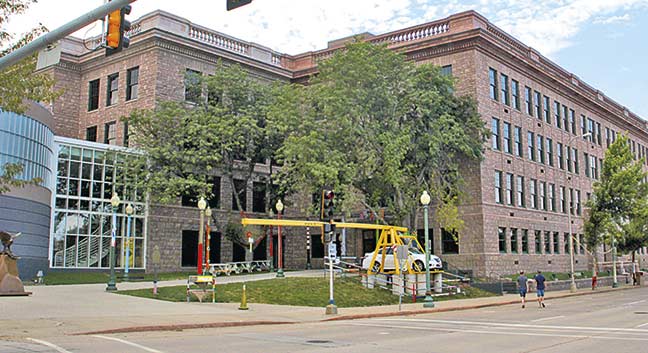
The Washington Pavilion with a performing arts center, a visual arts center and a hands-on science center within its walls opened in 1999 after years of effort. It served as an inspiration for later dreams.
“The Pavilion raised the bar for what we can do in Sioux Falls,” said Teri Schmidt, CEO of Experience Sioux Falls, the destination marketing organization for the city. “It is one of the top stars in our community not only for what it provides and offers everyone, but it is the perfect example of joining together and getting things done.”
Henkin was serving on the Chamber board when arts supporters Mary Allman and Sheila Agee brought the concept of an arts and science center before board members.
“The Chamber board endorsed the concept of renovating the building, not tearing it down,” he said. “One good thing leads to another good thing.”
When Sioux Falls voters narrowly approved a $33 million bond to build a new convention center and renovate the old high school on Oct 19, 1993, it was the culmination of years of work. Visionaries had promoted a convention center for years, and it had lost in earlier elections, while the Washington Pavilion was a new concept.
In the end, private funds came to $15 million to $16 million in donations, or about half of the total needed. Smith doesn’t think people are aware of how remarkable that effort was.
Premier Events come to Sioux Falls
The Sioux Falls Convention Center opened in 1996. Building on this momentum, in 2014 the Denny Sanford PREMIER Center, attached to Convention Center’s west side, welcomed its first events. With these developments, it ended a time when performers skipped Sioux Falls in favor of larger, more modern venues with better acoustics down the road.
“We were losing all that money, the opportunity to bring in currency when people came and stayed for a day or two,” Beacom said.
Although there were doubters, wondering if it could compete with venues in larger cities and be financially viable, many businesses and organizations saw positive aspects of a larger event venue, Beacom said.
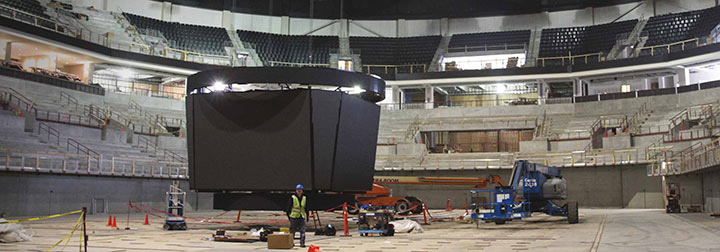
The pace quickened when Mike Huether moved into the Sioux Falls mayor’s office in 2010, Beacom said. Still, without the private sector’s involvement, the PREMIER Center could not have been built. Key corporate sponsors, including T. Denny Sanford, provided private funding, while local businesses and the Greater Sioux Falls Chamber of Commerce advocated for the economic benefits the venue would bring.
In its first 10 years, the PREMIER Center has proven to be a major entertainment hub with concerts, national sporting events and conventions that bring in people from across the United States. Taking what many saw as a risk has proven to be an economic asset, and the 12,000-seat center has become a consistent money-maker for the city.
“The skills a community develops while working through such a large project as the PREMIER Center builds confidence for future projects to be successful,” Griffin said.
Levitt at the Falls Defies the Odds
Sometimes, it’s not only residents who need to be convinced. When it came to bringing an outdoor music amphitheater to the Falls Park area, the first obstacle was convincing the sponsoring organization.
Tom Dempster was there at the beginning. A former Washington High School classmate, Tim Boe, was familiar with the Levitt Foundation efforts to bring free concerts to various cities. It was Boe’s dream to have a Levitt facility open in Sioux Falls, Dempster said, and Boe sent Dempster a packet of information.
Dempster took that dream and ran with it, pulling together people he thought would be interested. In a meeting at his home, he explained the concept. Even in that group there were doubters.
One of those members who was crucial in this entire process confessed his doubts years later. Despite
his support, he told Dempster, he never thought it would happen.
The enthusiasm grew, however, and Sharon Yazowski, now Levitt Foundation president and CEO, came to Sioux Falls. She gave a presentation to the group of volunteers, and in turn the group offered their own presentation, one that displayed their passion and determination to get it done.
“Levitt never said no, but they did say Sioux Falls was too small,” Dempster said. “I don’t remember whether 400,000 or 500,000 (people) was the minimum number, but Sharon said, ‘you guys are below that threshold, but you are so focused and you are so excited about this, we’re going to look beyond.”
A unique public-private partnership made Levitt at the Falls possible. The city contributed funding and designated land for the venue, but private donors and national Levitt Foundation grants made the project financially viable.
The Greater Sioux Falls Chamber of Commerce championed the effort, helping to raise awareness and emphasizing the cultural and economic benefits of a free, high-quality music experience for all residents.
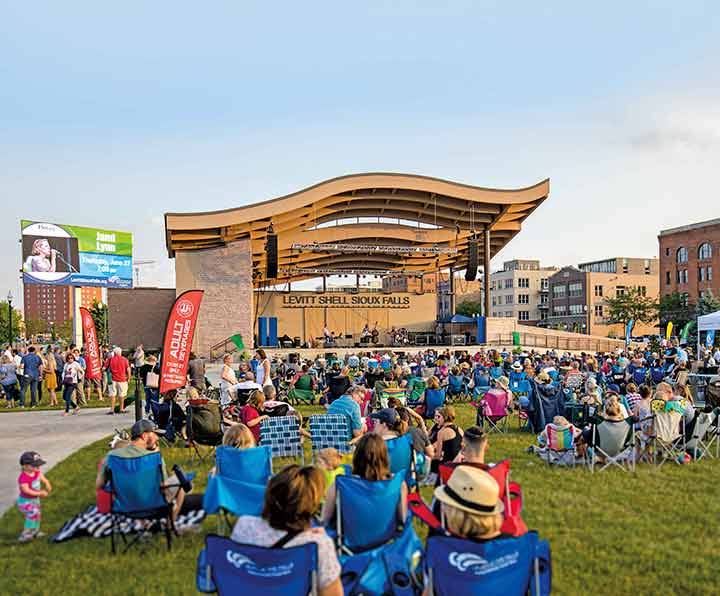
Since it opened in 2019, Levitt at the Falls has consistently drawn larger crowds than similar Levitt Foundation sites in much larger cities.
When Dempster talks about the Levitt, he refers to a comment made by Jennifer Kirby, then the Levitt at the Falls board chair, at the venue’s opening ceremony. When asked how it happened, she shrugged, put up her hands and said, “I don’t know, it’s magic. It’s just magic.”
She knew, of course, that magic takes a lot of effort, a lot of meetings and a lot of fundraising. The 10 to 15 citizens who put together a nonprofit private entity made presentations to Mayor Huether, to the city Parks & Recreation Department board and to its director, Don Kearney. His support and the board were crucial to the process, Dempster said.
Kearney saw that Levitt at the Falls could be an anchor for the city’s vision for the Falls Park area, Dempster said. Even with his support, the process seemed too slow to many local Levitt board members. But as a former state senator and Minnehaha County commissioner, Dempster knows that the pace of government can frustrate the private sector.
“Finally, we as a board in our meetings came to the thought, we’re going to be patient, we’re going to be
persistent and when the city’s ready, we’ll be ready. There were at least three times where we had a vote amongst our board whether we should proceed. Those were heart-in-your-throat votes.”
After that support was in place, the group turned to the Chamber of Commerce and applied to be a Community Appeals Campaign beneficiary. That group unanimously approved a $1.2 million fundraising effort. With that backing, supporters knew the project would succeed.
“I believe that without the Community Appeals support the project never would have happened,” Dempster
said. “What’s cool about this story is not that it happened, but how it has just exploded well beyond
anybody’s expectations.”
Levitt at the Falls this year will begin a $4.5 million makeover with Dick and Kathy Sweetman as the lead donors. The largest portion of the expansion will sit on the west side of the current band shell. The grassy area on the venue’s southwest corner will become a 2,600-square-foot programming space where the Levitt can host summer camps and professional development events for artists.
“It’s all about working together and saying we can do things that many people think are beyond our capacity to accomplish,” Dempster said.
State Theater Dream becomes a Reality
Another example of people working together on a dream stands several blocks south of the Levitt on Phillips Avenue—the State Theatre. When Allison Weiland steps into the iconic lobby, the power of public-private partnerships in making projects—and dreams—reality and the Greater Sioux Falls Chamber of Commerce’s crucial role in advocating for them surrounds her.
“Oh, man, walking into this building every day is amazing,” said Weiland, executive director of the Sioux Falls State Theatre Company. “You get to see all the pieces of history; you get to see all the artistry that is part of the building, and we get to program for the community that supported it. It’s really fun to walk through the door after all the years of donations and support.”
Weiland knows that many people doubted that the movie palace originally built in 1926 could be saved. Closed since 1991, some people thought restoring the building was too expensive, too ambitious and impractical. Big historic projects are complicated but unique, Weiland said. Despite challenges over the years, the State Theatre visionaries have doubled down on their efforts and continue to feel confident, she said.
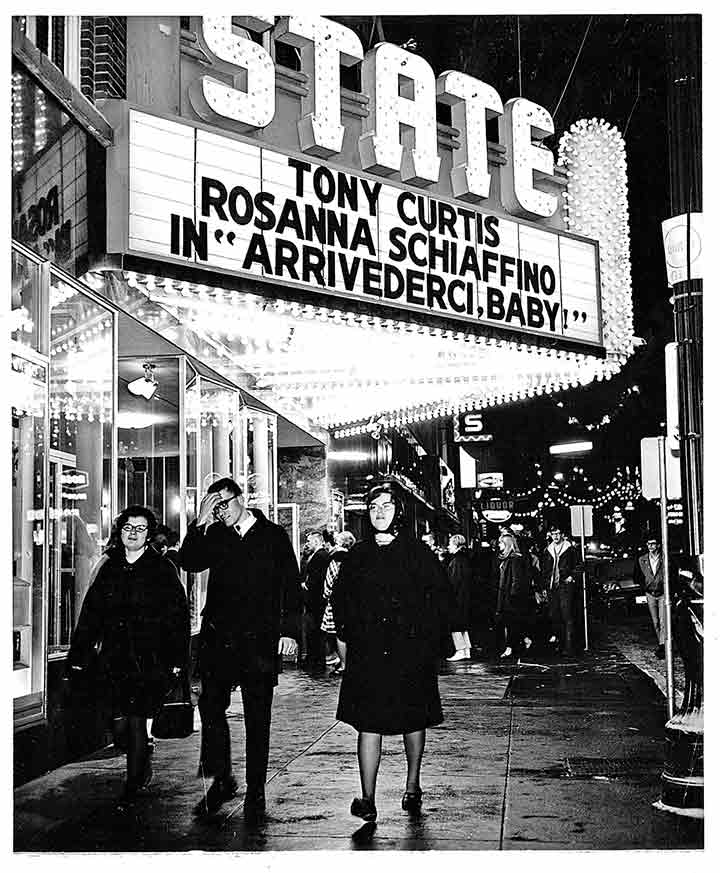
It took much collaboration and perseverance over the years, but today the State Theatre is an excellent example of public support, private donations and advocacy from organizations such as the Greater Sioux Falls Chamber of Commerce, Weiland said.
It took almost three decades to overcome funding issues and skeptics who questioned whether downtown Sioux Falls even needed a historic movie theater when modern cinemas were readily available.
But after a multi-phase restoration, with some work yet undone, the State Theatre reopened in 2020.
“People could see progress being made,” Henkin said. “It was going to be an original building back to its original state. More people came forward to take it over the top.”
A renovated State Theatre helped reignite the downtown area, Henkin said. Sioux Falls has become an example to many other cities in the Midwest for its ability to work together to complete projects. Completing the State ignited the visions of many others locally, he said.
“If something is in disrepair, or the city needs something, Sioux Falls has always had the extra oomph with the municipality, the county, the Chamber and private citizens getting things done,” Henkin said. “Sioux Falls has always had that ability that when they have a challenge and a need, they got the right people at the table.”
Henkin now lives in Omaha, Nebraska, home of the famed Old Market, a destination for tourists seeking shops and restaurants. The city has almost finished a total renovation of a downtown park that extends for blocks to the river. Sound familiar? A friend of Henkin believes it’s not unlikely that Sioux Falls’ progress spurred Omaha to act.
Henkin himself marvels at the changes he sees on trips back. He thinks three things spurred the change: the city’s decision to halt the once-popular practice of “shooting the loop,” or driving in endless circles around downtown, cleaning up Falls Park and reopening the State Theatre.
“It’s incredible what good development and planning has done,” he said.
Coming Together to Achieve Successful Results
Sioux Falls is home to multiple dreamers, Schmidt said. Without them, and without dreaming big, a city will
get nowhere.
“Time after time, I’ve seen leaders come to the table, take off their individual hats and say, ‘let’s get together to get this done.’ I believe that is the key to much of our success in Sioux Falls,” she said.
Years ago, a consultant told Schmidt that Sioux Falls will probably always be a destination city for travelers because the city adds great attractions constantly. The Washington Pavilion, the State Theatre, Levitt at the Falls and the PREMIER Center are quality attractions that bring people to Sioux Falls for entertainment and education, Schmidt said.
The skills a community develops while working through such a large project as the PREMIER Center builds confidence for future projects to be successful, Griffin said. He has had other cities reaching out, asking how Sioux Falls accomplished projects.
“It’s rare for a community to navigate competing interests and still come together to achieve such a successful result,” Griffin said.
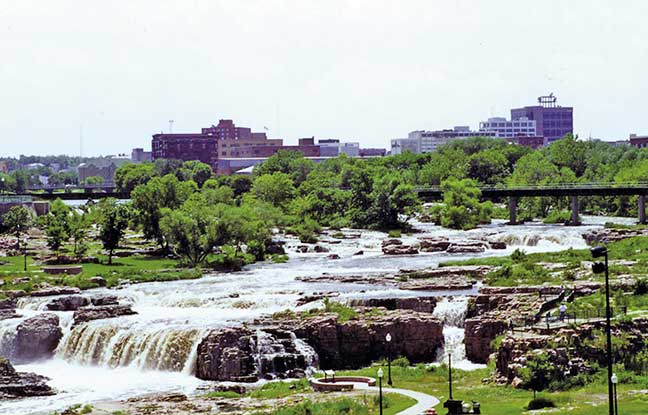
In Sioux Falls an ambitious project can become reality, Weiland said.
“You’re able to access and talk to experts and able to talk to someone on the city council. You’re able to get involved and meet people, who are sometimes only a phone call away.”
Sioux Falls’ success over the last century has been amazing, Beacom said. That’s because people aren’t afraid to raise their hands when they have an idea or dream that they want to see become reality. As Sioux Falls grew, it didn’t lose its personal connection.
“Never underestimate the value of relationships,” Beacom said. “We see that as key.”
Reared in Sioux Falls, Beacom remembers when Falls Park was not an after-dark destination for people. Now, every Christmas holiday he takes his mother-in-law and others to see the park’s Winter Wonderland display of lights.
In his decades in banking and as a community supporter, Beacom has seen leadership change, but the enthusiasm never wanes.
“Look at the leaders in Sioux Falls 20 or 30 years ago, and look at leadership today, and it won’t be the same
20 or 30 years from now,” he said. “We have to make sure we continue to grow, and young entrepreneurs, that’s their responsibility.”
Smith, who moved from city government to the Washington Pavilion leadership, said Sioux Falls benefits from two things: an extremely strong and progressive business community combined with effective elected officials.
“The officials have had a vision over the years and a spirit of cooperation and partnership with the private sector,” Smith said.
The word magic also comes up in conversations with Beacom. He likes to compare Sioux Falls to Disney theme parks. They are magical but make-believe, he said.
“Sioux Falls is magical, and it’s real people constantly working together to improve our city,” Beacom said.
A new PREMIER Bankcard executive told Beacom that Sioux Falls is the “most amenitized city” he’d ever seen, per capita, and that compliment to the city is the result of people working together, Beacom said. Sioux Falls leaders have the confidence to believe the city can compete with any community, it just needs a chance.
“We don’t like to hear, ‘no, you can’t do it, you’re too small,’” Beacom said. “How does Sioux Falls have this? We have great people that contribute.”
As for the future? Dempster, for one, is sure of this: What Sioux Falls will do is what it’s always done, benefit from residents willing to work well together.